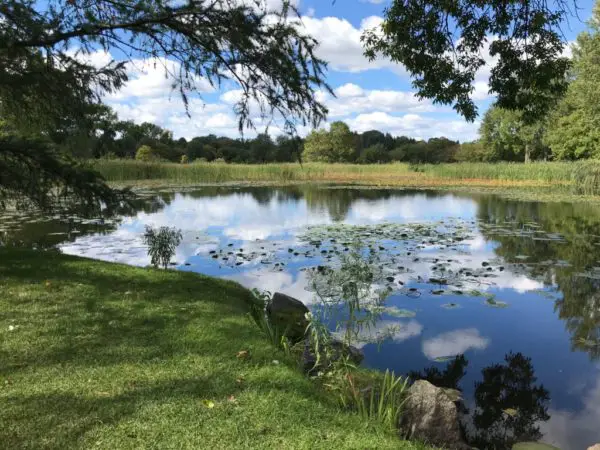You may have read in a forum that someone was trying out RID-X in their pond to clear some of the muck out. Is that a good idea, and does it work?
Put Ridex (spelled RID-X) in your pond if you do not have any living organisms in the water or nearby the pond. RID-X is a product specifically designed to restore waste eating bacteria to a septic system. This product is not designed to be used on living things such as animals or plants.
What would happen if you put RID-X in your pond? What are other ways to clear muck out from your pond?
RID-X Bacteria
Why use RID-X? When you have put something down the drain that has killed the natural bacteria in your septic system, such as bleach or anti-bacterial soaps and cleaners, you might need to add extra waste eating bacteria back into your system.
If you don’t have enough waste eating bacteria, then your septic tank can get backed up and clogged. This can cause damage to your pipes and system. Using RID-X would restore the natural bacteria to your septic system and prevent future problems.
RID-X claims to use natural bacteria in their products to break down waste:
- Cellulase breaks down toilet paper, vegetable matter and some foods
- Lipase breaks down fats, oils and grease
- Protease breaks down proteins
- Amylase breaks down starches
Source
People have theorized that adding these natural waste eating bacteria to their backyard ponds would help to break down waste buildup at the bottom of their pond, such as leaves, dead plants, or even dead fish. However, this is not a good idea.
Because RID-X claims to be all natural, it might be tempting to think that it would be safe to use in a pond setting, but the bacteria in RID-X is not found in freshwater ponds.
You would be introducing foreign bacteria to your already established ecosystem. This foreign bacteria has the potential to increase rapidly, and as the amount of bacteria increases, the amount of nutrients in your pond will decrease. This potential decrease in nutrients could be extremely harmful to plant and animal life in your pond and should be avoided.
Dangers of Using RID-X in Ponds
RID-X is not designed to be used with living organisms, such as plants and animals, and company does not recommend that you do so.
“Used according to directions, the all-natural ingredients in RID-X® won’t harm plants. However, it should not be applied directly to the lawn or plants. . . we do not recommend that the pets drink from the toilet after using RID-X®.”
Source
Even though the company claims that their product shouldn’t harm plants, they still say that it shouldn’t be directly applied. If you put RID-X in your pond, you would be directly applying it to any plants that may be in your pond or on the bank of your pond.
Likewise, RID-X does not recommend that you allow your pets to drink from the toilet (which is where you apply their product) even though it is “all-natural.” Putting RID-X in your pond would be similar to letting your dog directly lick the product. It just isn’t a good idea. Your fish are the dogs of your pond, and they should not be exposed to RID-X if you want them to be healthy and happy.
If you have other pets, such as dogs or cats, it could be dangerous to put RID-X in your pond in case your pet decides to play in the water or drink from the water. Likewise with children: if your kids play in the pond, the RID-X could be harmful to them and is not recommended.
Having some sort of a fountain or waterfall is a common feature found in ponds. While these features create a lovely effect of moving water, they also cause splashing. If you put RID-X in your pond, then the splashing water could be harmful to any nearby plants that the water may land on.
Safer Alternatives for Cleaning Your Pond
If you have a large buildup of muck on the bottom of your pond that you just aren’t sure how to tackle, there are a few different things you can try instead of using RID-X.
You can invest in a pond vacuum. Pond vacuums are a safe way to suck out any unwanted muck and sludge from the top or bottom of your pond. They have long hoses and handles to reach down into the depths of your pond so that you do not have to get into the water yourself. Pond vacs are also safe for fish, so you can use them even if you have animal life in your pond.
Another way to clean the bottom of your pond is to empty the pond and clean it by hand. This should not be done often, as it is harmful for your ecosystem, but if your pond needs a serious deep clean, then it might be necessary to empty it out and start fresh.
If your biggest problem in your pond is unwanted algae buildup, an easy solution is to dye the water in your pond. Dying your pond darkens the color of the water and doesn’t allow as much sunlight to your plants. This is a great way to kill off algae, as algae loves sunlight. The less sunlight in your pond, the less algae. Just don’t forget to scoop out the dead algae from the bottom of your pond. Dead algae sinks.
Dirty ponds not only look bad, but are also terrible for the health of your fish. Too much muck in the bottom of your pond gives off gasses that can be toxic. You should not let your pond get dirty enough to need to use something harsh like RID-X to clean the muck out from the bottom. Keep up with the cleaning and you should not need to result to drastic measures.

